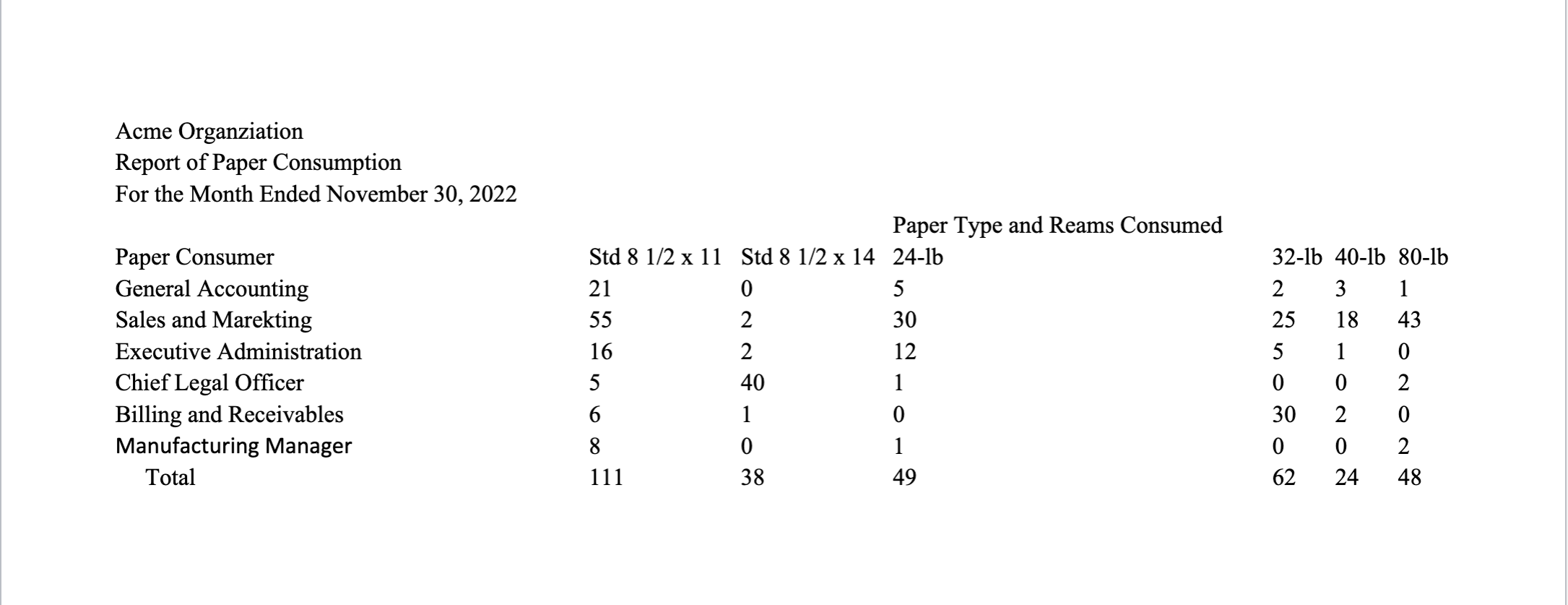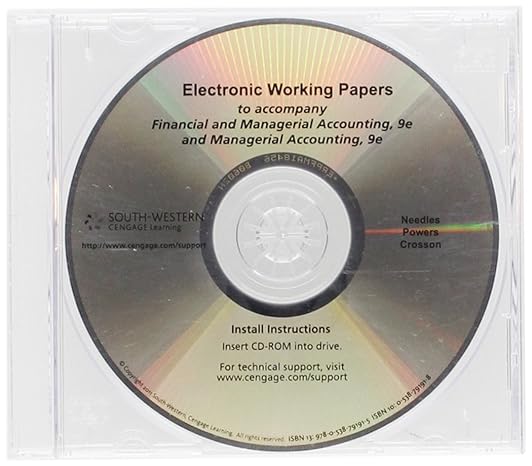Question
To start Project #2, please read the following document thoroughly: Project #2 Five Principles of Financial Reporting 2021.pdf Download Project #2 Five Principles of Financial
To start Project #2, please read the following document thoroughly:
Project #2 Five Principles of Financial Reporting 2021.pdf Download Project #2 Five Principles of Financial Reporting 2021.pdf
First Documents:
Five Principles of Financial Reporting ACCT 356 Project The five principles of financial reporting (ACCURACY, CONSISTENCY, APPEARANCE, EFFICIENCY, and USABILITY, with occasional overlap between them) are discussed in detail below. Your assignment is to edit the provided base spreadsheet report to ensure that all five principles of financial reporting are executed well in the final submitted version. The base report, generated using Microsoft Excel, was issued by an internal service center responsible for supplying paper to various departments in a large organization. Determining that this financial report has problems is a critical first step, but understanding the specific nature of the reporting problems is important to producing higher quality financial reports in the future. Accuracy The accuracy principle involves ensuring that the content of a financial report properly represents what it purports to represent. It involves, for example, ensuring that the written components and titles / labels in the reporting are free from spelling and grammatical errors, and that the data presented is associated with the time period(s) indicated. It should also involve ensuring that the titles and descriptions that are included in the financial reporting are consistent with the actual amounts that are included in the financial reporting. For example, an amount reported as wages expense on a report should in fact be the amount of wages expense for the period and not some other expense. And, of course, the amounts need to be accurate, with recognition that accounting requires judgment and estimation. While financial report amounts might not often match exactly the true amount (that often cannot be known exactly until sometime in the future), they should be verifiable against standard data sources to be considered accurate. Please address the accuracy issues in the report now. Consistency The consistency principle involves ensuring that the format and layout of a financial report are similar to prior issuances of the same report and/or other reports issued by the same department. In many organizations, certain individuals or departments (such as the CFO or the board of
directors) will receive many different financial reports each period. Having a consistent (and, in certain cases, distinctive) format or feel for each report or for each issuing department will allow the recipient to quickly identify a needed report for a specific related decision. Consistency also involves ensuring that titles and descriptions remain the same from one period to the next, so that recipients know that the same financial information is being reported. (Changing a column or row label, even slightly, could lead a recipient to question whether something different is now being reported.) Fonts and other format attributes should also be consistent to be in compliance with the principle. In this case, the Chief Legal Officer directs the Legal Services department, and the Manufacturing Manager directs the Operations department. Please address the consistency issues in the report now. Appearance The appearance principle involves ensuring that the financial report is aesthetically pleasing but also professional. (Accounting is an art that uses a science!) Aesthetically pleasing financial reports should include proper alignments and make appropriate use of white space, borders, shading, and color. The purpose of most financial reports is to support decision making, and improving the appearance of the report can often help to draw the attention of the recipient decision maker to the most relevant data items (and can avoid distracting the recipient). For example, inserting a blank row above and/or double-underlining a very important financial statement amount naturally attracts the gaze of the reader. Please improve the appearance of the report now.
Efficiency The efficiency principle involves ensuring that a standard financial report can be prepared as quickly and easily as possible. This principle often involves utilizing automated or formulaic fields where possible. This will help to minimize the data entry and computations necessary for the preparation of financial reports. Hard-wired numerical totals should be avoided. If possible, building financial reports to extract data directly from the underlying accounting system, both for labels and amounts, can create the greatest efficiency. And efficiency should relate not only to the preparation of financial reports but also the use of financial reports, where helping to ensure that relevant decisions are efficiently supported is important. In this case, the purpose for the financial report is for the internal service center to request reimbursement for the paper provided to each consumer group. The letter size (8 x 11) reams cost $8 each, the legal size (8 x 14) reams cost $10 each, the bond stock (24-lb) reams cost $12 each, the stationery (32-lb) reams cost $12 each, the form stock (40-lb) reams cost $15 each, and the card stock (80-lb) reams cost $20 each. A ream includes 500 sheets for printer, legal, and bond stock, but a ream is only 250 sheets for stationery, form stock, and card stock. Try to increase the efficiency of the report now. Usability The usability principle relates very specifically to decision support for the report recipients. It involves considering how the financial report will be disseminated. In that regard, financial report data should be organized to allow for ease of extraction by recipients. It should also be easily understandable given the specific background(s) of the recipients. And financial reports should be formatted for duplication, where appropriate, or for posting to websites (to be accessible using a variety of electronic devices and a variety of internet browsers). For example, whereas use of shading and color may be deemed worthwhile to improve the appearance of a financial report, it
might make the report less suited for duplication. Make your finishing touches involving usability now. Summary and Conclusion While reporting style preferences will vary, and financial reports will not generally be perfect, greater attention to these principles should allow accounting professionals to improve the quality of reporting.
After you understand the objectives of the report and the five principles, work on improving the following base spreadsheet.
Project 2 Base Spreadsheet 2021.xlsx Download Project 2 Base Spreadsheet 2021.xlsx
Second Document: It is done in excel
Step by Step Solution
There are 3 Steps involved in it
Step: 1

Get Instant Access to Expert-Tailored Solutions
See step-by-step solutions with expert insights and AI powered tools for academic success
Step: 2

Step: 3

Ace Your Homework with AI
Get the answers you need in no time with our AI-driven, step-by-step assistance
Get Started


